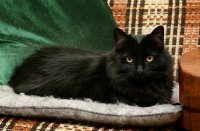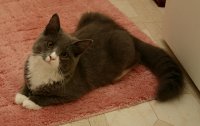You are using an out of date browser. It may not display this or other websites correctly.
You should upgrade or use an alternative browser.
You should upgrade or use an alternative browser.
rack'm
Jaded
Mousebaby said:Well, I tried it with the flash on, and with the flash off. With the flash on way too much light, with the flash off not enough light. So then I tried uping the shutter speed and trying it with the flash off and it still came out too dark. Maybe I'm just too stupid to be doing this. :shrug:
What kind of camera is it??
Have you purchased an external flash?
ylexot
Super Genius
When you up the shutter speed, the camera automagically adjusts the aperture to get the same exposure (unless you have it on full manual). Does the camera have an "exposure compensation" setting? If it does, use that to decrease the exposure.Mousebaby said:Well, I tried it with the flash on, and with the flash off. With the flash on way too much light, with the flash off not enough light. So then I tried uping the shutter speed and trying it with the flash off and it still came out too dark. Maybe I'm just too stupid to be doing this. :shrug:
hvp05
Methodically disorganized
Use an external flash to employ bounced light.Mousebaby said:My camera seems to be using too much light when I take pictures. I have tried adjusting the shutter speed like my book suggested but they are still coming out way too bright! What else can I do?

On-camera flashes just aren't very good, relatively. Even if you are adjusting your shutter, your camera may still be in control of the aperture, and it may be setting a wider aperture to compensate for your faster shutter. Try this: Record your camera's exposure settings (shutter speed + aperture) right before a shot. Go into Manual, and leave one of the settings the same, but change the other so you get a darker meter reading. Compare the two results.
Your camera may be resetting your shutter speed if you set it above a certain point. Flashes typically sync at 1/250 sec., so even if you set 1/500 sec., your camera will still fall back to 1/250 sec. and the result will, of course, be no different.Mousebaby said:Well, I tried it with the flash on, and with the flash off. With the flash on way too much light, with the flash off not enough light. So then I tried uping the shutter speed and trying it with the flash off and it still came out too dark.
Have you tried working with your ISO - like going up to 400 or 800 - and the flash off?
And, judging by the one photo, it looks like you are directly in front of your cat. Move back to approximately 3 feet, and, if you want a closer composition, use that powerful zoom. Receding from the subject spreads the flash over a wider area, so it not be so intense. And, if you want a quick, cheap softbox effect, hold a piece of tissue paper in front of the flash as you shoot.
hvp05
Methodically disorganized
Heh, I didn't think of that one...ylexot said:"exposure compensation"
M
Mousebaby
Guest
Oh man my head is spinning, I will try all of the above suggestions. Sorry I didn't get back to you sooner, I had a few things to do, then a nap kind of grabbed me from out of nowhere! 
As far as me being right on top of my cat, I wasn't. She was completely across the bed at the end of it sitting on the dog crate. :shrug: You've got me as to why its so bright. I didn't have this problem with my Kodak. It always took great pictures. I'm wishing now I hadn't sold it and bought this one. This one is going to drive me bananas!
Ok, just looked at the camera, it does have "exposure compensation" I am going to play around with that and see what happens.

As far as me being right on top of my cat, I wasn't. She was completely across the bed at the end of it sitting on the dog crate. :shrug: You've got me as to why its so bright. I didn't have this problem with my Kodak. It always took great pictures. I'm wishing now I hadn't sold it and bought this one. This one is going to drive me bananas!

Ok, just looked at the camera, it does have "exposure compensation" I am going to play around with that and see what happens.

M
Mousebaby
Guest
Ok, here's what I got when I played with the "exposure compensation" and shutter speed. Also, the camera has a setting for cool, warm, sepia and so on and I had it on cool so I turned it off. I think the test subject came out perfect. What do you think?? 
ps, they were clean across the room, so my zoom is great!!!

ps, they were clean across the room, so my zoom is great!!!
hvp05
Methodically disorganized
Those only alter the color tone, not exposure, and certainly not the flash. You can have over/underexposed photos in any of those modes.Mousebaby said:Also, the camera has a setting for cool, warm, sepia and so on and I had it on cool so I turned it off.
It is better... and I noticed it's a different cat, also. The first one was a mostly-dark cat in front of a dark background; this one is lighter toned over all, which may have affected the camera's metering.Mousebaby said:I think the test subject came out perfect. What do you think??
M
Mousebaby
Guest
hvp05 said:Those only alter the color tone, not exposure, and certainly not the flash. You can have over/underexposed photos in any of those modes.
It is better... and I noticed it's a different cat, also. The first one was a mostly-dark cat in front of a dark background; this one is lighter toned over all, which may have affected the camera's metering.
How's this one?
hvp05
Methodically disorganized
Better than the first one.Mousebaby said:How's this one?
I have included three of my two cats. One is all black and it's difficult to get a nice shot of her. All used bounced flash, which gives a nice, unforced lighting.
Attachments
M
Mousebaby
Guest
ok, how do you get unforced lighting. I have a setting for auto flash, auto/red eye, and forced flash on. I have looked through my index and see nothing about being able to use an external flash. Rackem suggested an external flash. I looked through the accessories you can buy for this camera and that is not one of them. So now what? 

M
Mousebaby
Guest
I don't know what I'm doing wrong, I just cannot get a decent picture of the black and white cat. I have tried dozens of things. Nothing is working. I can get passable ones of my orange cat, but not like yours, I can actually see depth in your pictures. Mine look flat! I am getting a bit frustrated so I am going to put it down for a while.
rack'm
Jaded
Mousebaby said:I don't know what I'm doing wrong, I just cannot get a decent picture of the black and white cat. I have tried dozens of things. Nothing is working. I can get passable ones of my orange cat, but not like yours, I can actually see depth in your pictures. Mine look flat! I am getting a bit frustrated so I am going to put it down for a while.
Ok, switch gears.......go with a light and do away with the flash....a softbox of sorts.
M
Mousebaby
Guest
rack'm said:Ok, switch gears.......go with a light and do away with the flash....a softbox of sorts.
Alright, here's one with just an overhead light. I think it came out great!

rack'm
Jaded
Mousebaby said:Alright, here's one with just an overhead light. I think it came out great!
Better
 but now move a lamp so you can use directional light to light up the cats face for detail.
but now move a lamp so you can use directional light to light up the cats face for detail. 
M
Mousebaby
Guest
rack'm said:Betterbut now move a lamp so you can use directional light to light up the cats face for detail.


rack'm
Jaded
Mousebaby said:Ok, but I think you might have to come help the hubby repair the hole in my ceiling!


M
Mousebaby
Guest
rack'm said:Betterbut now move a lamp so you can use directional light to light up the cats face for detail.

Ok, one more try and I really am quitting for tonight, starting to get a headache!

hvp05
Methodically disorganized
I think you are learning why on-camera flashes are not so great... they are hard to control and not particularly flexible.Mousebaby said:ok, how do you get unforced lighting. I have a setting for auto flash, auto/red eye, and forced flash on. I have looked through my index and see nothing about being able to use an external flash. Rackem suggested an external flash. I looked through the accessories you can buy for this camera and that is not one of them. So now what?
An external flash looks like this. With it you can angle the head to bring in light from different angles, and to create a softer effect. The catch is you need a hotshoe (look at this camera immediately to the right of the mode dial (lower left)), and your camera does not seem to have this connection.
Rack'm's idea was good, though; bring in a lamp and some sort of diffuser (tissue paper or thin cloth) or reflector (bed sheet, tin foil, etc.)
Then you just have to hope that, after spending 10 minutes to set up, your cat does not wake up and walk away.

M
Mousebaby
Guest
hvp05 said:I think you are learning why on-camera flashes are not so great... they are hard to control and not particularly flexible.
An external flash looks like this. With it you can angle the head to bring in light from different angles, and to create a softer effect. The catch is you need a hotshoe (look at this camera immediately to the right of the mode dial (lower left)), and your camera does not seem to have this connection.
Rack'm's idea was good, though; bring in a lamp and some sort of diffuser (tissue paper or thin cloth) or reflector (bed sheet, tin foil, etc.)
Then you just have to hope that, after spending 10 minutes to set up, your cat does not wake up and walk away.
Ok, I checked out the place where I bought the camera and they have a selection of flash shades/covers. Is this an idea perhaps?



